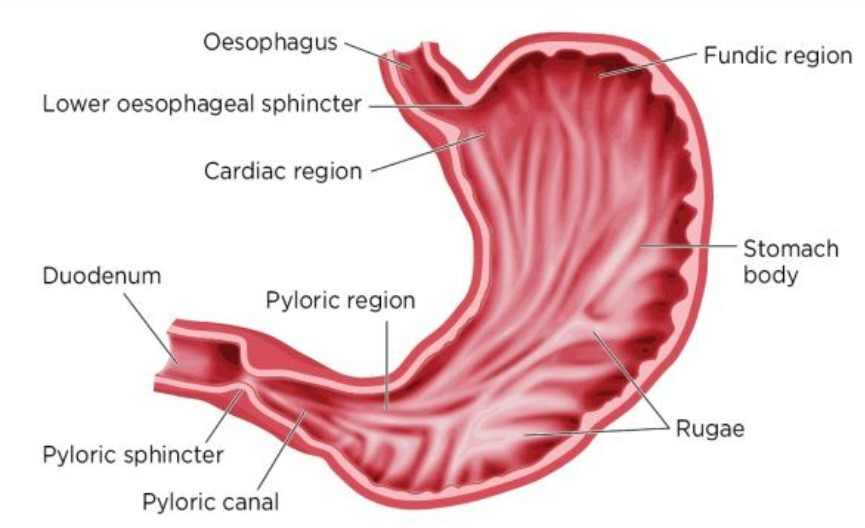
What are the structures and regions of the stomach?
Answer
390.3k+ views
Hint: Stomach is a J-shaped structure and lies between duodenum and esophagus. It lies just behind the diaphragm and towards the left of the abdominal cavity. It acts as a flexible organ in the body, which is able to hold up to three liters of food. It is a bag-like organ of the digestive system. It receives food from the esophageal region and passes it to the small intestine. A typical adult stomach is $15.2$cm wide and $30.5$cm long.
Complete answer

Fig: Parts of a Stomach
Stomach can be classified into four parts, namely:
1. Fundus or fundic region
2. Stomach body or intermediate region
3. Antrum
4. Pylorus or pyloric region
Fundus – it is an expanded area, which is curving up above the cardiac opening (cardiac opening is opening from the stomach into the esophageal region). It is a dome-shaped region, which exists in the top-left.
Stomach body – It is the central portion of the stomach, which is the largest structure. It is the expansive and main stomach chamber.
Antrum – it is a lower part of the stomach, which is a funnel-shaped region.
Pylorus – it is a narrowing region, where the stomach meets the small intestine. It connects duodenum and stomach.
Both cardiac and pyloric regions possess sphincter muscles, which keeps the neighboring region closed, with the exception during the food passage time.
Rugae are prominent folds present in the inner mucosal lining, which perform expansion.
Note:
Stomach performs some functions. It churns the food into a semi fluid acidic substance, called chyme. It kills any germs in food through the presence of hydrochloric acid. It aids in the partial digestion of foods and breakdown of proteins. It acts as a reservoir for ingested food. Further, it also behaves as a mixing and digestion chamber. It has two openings, one in the esophageal region and another in the duodenal region.
Complete answer

Fig: Parts of a Stomach
Stomach can be classified into four parts, namely:
1. Fundus or fundic region
2. Stomach body or intermediate region
3. Antrum
4. Pylorus or pyloric region
Fundus – it is an expanded area, which is curving up above the cardiac opening (cardiac opening is opening from the stomach into the esophageal region). It is a dome-shaped region, which exists in the top-left.
Stomach body – It is the central portion of the stomach, which is the largest structure. It is the expansive and main stomach chamber.
Antrum – it is a lower part of the stomach, which is a funnel-shaped region.
Pylorus – it is a narrowing region, where the stomach meets the small intestine. It connects duodenum and stomach.
Both cardiac and pyloric regions possess sphincter muscles, which keeps the neighboring region closed, with the exception during the food passage time.
Rugae are prominent folds present in the inner mucosal lining, which perform expansion.
Note:
Stomach performs some functions. It churns the food into a semi fluid acidic substance, called chyme. It kills any germs in food through the presence of hydrochloric acid. It aids in the partial digestion of foods and breakdown of proteins. It acts as a reservoir for ingested food. Further, it also behaves as a mixing and digestion chamber. It has two openings, one in the esophageal region and another in the duodenal region.
Recently Updated Pages
The correct geometry and hybridization for XeF4 are class 11 chemistry CBSE

Water softening by Clarks process uses ACalcium bicarbonate class 11 chemistry CBSE

With reference to graphite and diamond which of the class 11 chemistry CBSE

A certain household has consumed 250 units of energy class 11 physics CBSE

The lightest metal known is A beryllium B lithium C class 11 chemistry CBSE

What is the formula mass of the iodine molecule class 11 chemistry CBSE

Trending doubts
State the laws of reflection of light

One Metric ton is equal to kg A 10000 B 1000 C 100 class 11 physics CBSE

Difference Between Prokaryotic Cells and Eukaryotic Cells

How do I convert ms to kmh Give an example class 11 physics CBSE

Give an example of a solid solution in which the solute class 11 chemistry CBSE

Describe the effects of the Second World War class 11 social science CBSE




